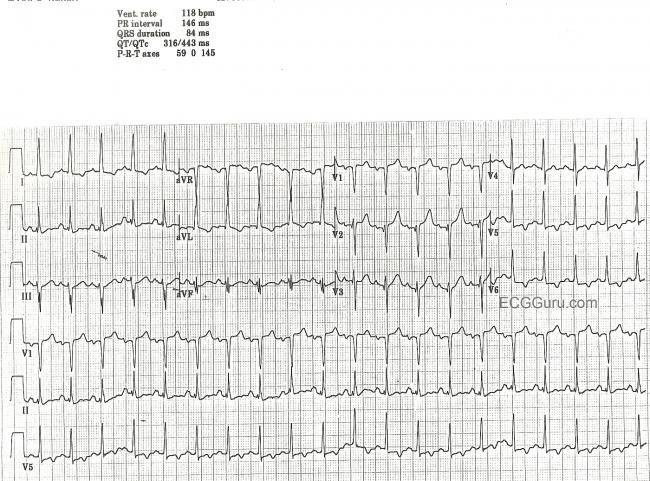I. Introduction
Coronary artery disease (CAD) in firefighters is due to a combination of workplace factors and personal factors such
Diabetes mellitus, hypertension, smoking, elevated blood cholesterol (HDL-C), obesity, and a lack of exercise (AHA, 2007). Although not as widely known, firefighters are also exposed to factors in the workplace which are also associated with adverse cardiac outcomes.
II. Cardiovascular effects associated with smoke
Think back to your first fire academy class. You learned that smoke is a combination of heated gases, vapors, and particulate matter. It is also important to remember that the composition of smoke is determined not only by its fuel source, but also by fire conditions such as oxygen availability and temperature (Kulig, 1991). While hundreds of decomposition products can be found, two gases with known cardiovascular effects are
carbon monoxide and
hydrogen cyanide.
Carbon monoxide (CO)
Carbon monoxide - a product of incomplete combustion - is present in
virtually all fire environments. One thing I think many of us are guilty of overlooking is the fact that high CO levels are usually still present during the overhaul phase of an operation and, to make that situation worse, it is during this phase of the operation that many firefighter's remove their self-contained breathing apparatus (SCBA). When CO is inhaled, it disrupts the transport of (and intracellular use of) oxygen which can result in a myocardial injury.
Hydrogen cyanide (HCN)
Hydrogen cyanide is formed due to the incomplete combustion of substances which contain both carbon and nitrogen (e.g. paper, cotton, and wool). It has frequently been detected in residential structure fires in levels that exceed established exposure limits. Like CO, hydrogen cyanide disrupts the intracellular use of oxygen resulting in intracellular hypoxia with cardiac manifestations.
Particulate matter
It's a well-known fact that firefighters are exposed to particulate matter contained in the smoke from a structure fire. (For those who might be reading this blog and not be associated with the fire service, particulate matter is the "
sum of all solid and liquid particles in air many of which are hazardous". Studies conducted in the general population have indicated that particulate matter, as a component of air pollution, has adverse cardiovascular effect. For example, short-term exposure to particulate matter has been shown to trigger heart attacks particularly in persons with pre-existing heart disease.
III. Why are we at higher risk
It is a well-known fact that sleep plays a vital role in helping our body recover from fatigue, illness, and stress. Without it, our metabolic rate begins to decrease resulting in weight gain. A firefighter's "internal biological clock"is often disrupted numerous times during a shift making it difficult to regulate the sleep-wake system. In addition, researcher's at
Boston Hospital and Medical Center have determined that prolonged sleep restriction combined with circadian rhythm disruption can be a contributing factor to an increased risk for diabetes.
 |
Electrocardiogram (ECG) tracing shows coronary
heart disease |
As if that wasn't bad enough, the
University of Chicago conducted research that shows a direct link between sleeping (or the lack of it) and a increased risk of cerebrovascular accident (stroke), myocardial infarction (MI), and congestive heart failure (CHF). According to their findings, an individual who sleeps more than eight (8) hours a night or less than six (6) hours a night has a significantly higher chance of experiencing chest pain or angina and developing
Coronary heart disease.
As a firefighter, we are exposed to traumatic stress almost every shift. If we work thirty (30) years that stress will take a toll on our body both physically and mentally. Researchers at the
University of California - San Francisco (UC San Francisco) have found that these exposures over the course of a lifetime will experience an increase in inflammation in their body even if they don't develop Post-Traumatic Stress Disorder (PTSD). These increased levels of inflammation also tend to put the person at a greater risk of having an MI. Intervention strategies to combat this stress, such as exercise, yoga, and other health-related activities should be integrated at the start of a firefighter's career.
IV. Conclusion
 |
Chicago Engine 29 operates at an early morning
warehouse fire. |
Firefighting in and of itself is a physically demanding job and will eventually break even the healthiest body down. According to a study performed at the
Illinois Fire Service Institute (IFSI), just three (3) hours of prolonged firefighting stiffens arteries and impairs function of the heart in young, healthy male firefighters. This same phenomena is seen in both heavy powerlifters and marathon runners. This means firefighters who do not value the importance of physical fitness are at a greater risk of exhibiting several factors of cardiovascular disease including being overweight and becoming hypertensive.
Additional information:
Firefighter deaths from cardiovascular events,
Heart disease and firefighters
References
American Heart Association (AHA) [2007]. Risk factors and coronary artery disease. Retrieved on September 19, 2017 from http://www.americanheart.org/presenter.
jhtml?identifier=4726
Hofman, John (September, 2012). Heart disease and firefighters: how and why? Retrieved on September 28, 2017 from http://www.fireengineering.com/articles/2012/09/heart-disease-and-firefighters-how-and-why.html
Kulig, K. [1991]. Cyanide antidotes and fire technology. New Eng J Med 325:1801-1802








